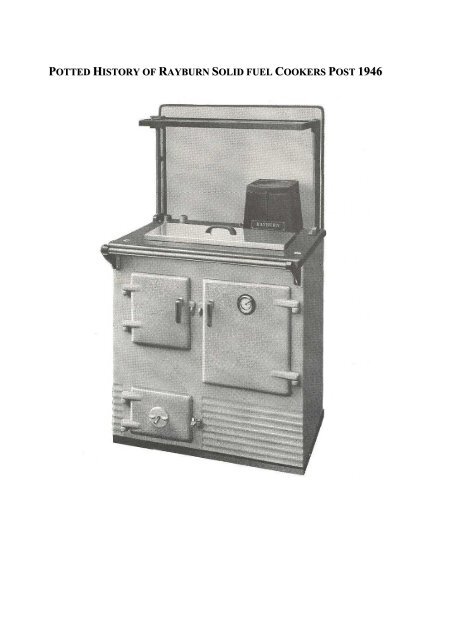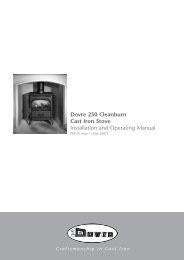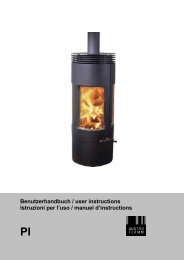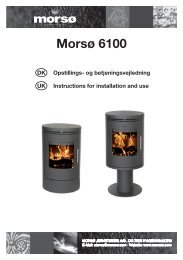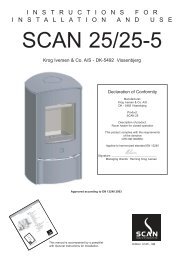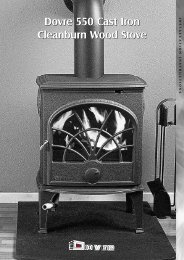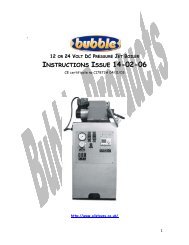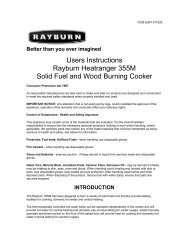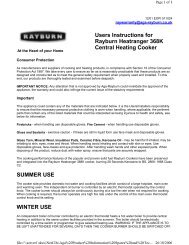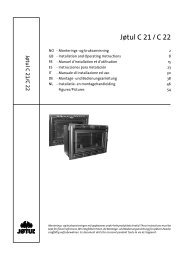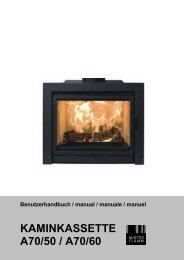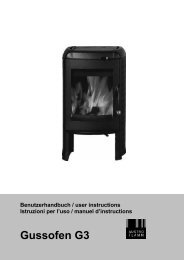potted history of rayburn solid fuel cookers post - Harworth Heating Ltd
potted history of rayburn solid fuel cookers post - Harworth Heating Ltd
potted history of rayburn solid fuel cookers post - Harworth Heating Ltd
Create successful ePaper yourself
Turn your PDF publications into a flip-book with our unique Google optimized e-Paper software.
POTTED HISTORY OF RAYBURN SOLID FUEL COOKERS POST 1946
1. INTRODUCTIONRayburn <strong>solid</strong> <strong>fuel</strong> <strong>cookers</strong> can, cook, heatwater, heat the kitchen, be <strong>fuel</strong>led by almostanything and when used and maintainedproperly, last a lifetime.What else could you possible want?They look great, they are easy to cleanexternally and the cast iron ovens are selfcleaning.Food cooked on Rayburn’s tastes wonderfulland some models can be used when there iseither no power or a power cut.It’s easy to see why the lovely <strong>cookers</strong> havebeen so popular for so long.<strong>Harworth</strong> <strong>Heating</strong>2. IDENTIFICATIONTHE NO 1The Rayburn Number 1 was the firstgeneration <strong>of</strong> 'Rayburn' cooker, introducedin 1946 and manufactured up to about 1958,when it was largely superceded by theintroduction <strong>of</strong> the Rayburn RegentBoth Old and New pattern had a single ovenand was available as a L.H. or R.H. ovenversion. The No. 1 is distinguished byhaving no insulating lid covering thehotplate.Each version had an optional boiler, whichwith 24 hours continuous burning, producedapproximately 90,000BTUs (26kW). Bothappliances required connection to a 30gallon hot water storage cylinder, either on adirect or indirect system. Alternatively anoptional side-tank could be used.The difference between the two models is inthe fire and ashpit doors. The old patternhad independent doors, whereas the newpattern had interlocking doors, where theashpit door cannot be opened before thefiredoor is opened.The firebricks were the same for eachmodel, but some were changed when built asnon-boiler versions - the boiler versionhaving a rectangular fire-grate and the nonboilera circular grate.The other feature that changed on thesemodels was the riddling method. This wasoriginally done by opening the ashpit door,but on later models outside riddling wasintroduced, requiring an alteration to thebottom side bricks to accommodate it.The cast iron boiler was referred to as the12" boiler and was available with sidetappings or top tappings.Optional extras available for adding tothe basic appliance were:-1. Loose insulating lid.2. Splash-back and plate-rack3. Plate-rack only4. Splashplate (low skirting)5. Handrail and brackets6. Oven thermometer7. Copper boiler8. Low pressure side tank <strong>of</strong> 17.5 gallons,for where no hot water storage system wasavailable.1
It was available with or without a hot-waterboiler and with a left or right-handed oven,also available were optional extras such as thesplash back, plate-rack, and a plinth to raiseby the height by 6 inches. The standard boilerwas plain cast iron, with the option <strong>of</strong> having itglass lined (enamelled) or <strong>of</strong> copperconstruction.Original Version Has Cast Lifting CoverDuring the 1970's the door handles werechanged to the horizontal pattern and the fluedamper was brought up above the hob, with aredesigned flue chamber.By 1988, the left-hand oven option wasdiscontinued.Production finally ceased by the mid 1990's.THE ROYALIntroduced in 1958, the Royal took over as adirect replacement for the Rayburn No 3, withwhich it shared many <strong>of</strong> the same features. Aone-piece insulating cover was standard, aswas the 'drop down' style door handles.A re-styled flue chamber was provided, but theflue damper remained below the hob, with anindicator registering on the back-plate.It was available with or without a hot-waterboiler and with left or right handed ovens, alsoavailable were optional extras such as thesplash back, plate-rack, drip tray and a plinthto raise by the height by 3.75 inches. Thestandard boiler was plain cast iron, with theoption <strong>of</strong> having it glass lined (enamelled) or <strong>of</strong>copper construction.In 1968 the option <strong>of</strong> twin insulating coverswere <strong>of</strong>fered, before becoming standard.During the 1970's the door handles werechanged to the horizontal pattern and the fluedamper was brought up above the hob, with aredesigned flue chamber.By 1988, the left-hand oven option wasdiscontinued.The mid 1990's saw more colour optionsintroduced together with chrome platedinsulating covers and were re-designated 200S& 212S. Later changes included slam catchoven doors.From 2005 onwards, the flue damper moved tothe front <strong>of</strong> the chamber and a positive catchwas added to the fire door.Production continues.Early in 2006, the model re-designated SFW toemphasise its wood burning capability.Rayburn Royal - Later Model Separate LidsLater Still Rayburn 212S with Chrome Lids3
THE SUPREMEwhich also altered the oven temperature byallowing more or less air to the fire grate.Available in a limited range <strong>of</strong> colours, it had abrown top-plate and enamelled lids and wasalso available in a Matt-finish black or brownenamel, the latter with brass colour fittings.Manufacture had ceased by 1992, beingreplaced by the Nouvelle, which had beenintroduced in the mid 1980's.RAYBURN SOLID FUEL NOUVELLERayburn 300W, 345W, 355S, 355M &355SFWThe Rayburn Supreme was introducedin 1982 for use with a range <strong>of</strong> <strong>solid</strong> <strong>fuel</strong>s andalso wood and peat. It provided cookingtogether with domestic hot water and heating.It was only produced with ovens on the righthand side.The fabricated steel boiler was originallyquoted as providing 35000BTU/Hr (10.3KW),based on a 4 hour re-<strong>fuel</strong>ling cycle, inaccordance with B.S. 1252. This was achievedby maintaining a high oven temperature andselecting the 'heating' position on the controldamper. The output figure reduced to20000BTU/Hr (5.8KW) when burning wood.During summer use when the firebrickpositions were changed, the output reduced to3.1KW (for <strong>solid</strong> <strong>fuel</strong> use) with the 'cooking'position <strong>of</strong> the control damper selected. Theboiler temperature was controlled using thethermostat sited at the rear <strong>of</strong> top plate.The appliance was fitted to a heating systemwith the circulating pump on the return pipebefore the junction <strong>of</strong> the return from theindirect cylinder. The domestic hot water isavailable constantly, while the appliance isalight, by using an open vented gravity feed190 Litre (40 gallon) cylinder. The pump canbe controlled by a programmer and/or roomthermostat, and it was recommended that aboiler low temperature return thermostat befitted.The hotplate had 2 hinged insulating lids, theheat being provided by the hot flue gasespassing across the underside. The temperaturebeing regulated by use <strong>of</strong> the spin wheel,The Rayburn Solid <strong>fuel</strong> Nouvelle wasintroduced in the mid 1980's, to initiate a newrange <strong>of</strong> central-heating <strong>cookers</strong> intended foruse with a range <strong>of</strong> <strong>solid</strong> <strong>fuel</strong>s and also woodand peat. Oil & Gas Nouvelle's weresubsequently introduced.Similar to the Rayburn Supreme, the Nouvelle<strong>of</strong>fered wider choice <strong>of</strong> colour options andchrome insulating covers.It provided cooking together with domestic hotwater and heating. It was only produced withovens on the right hand side.Advantage was taken to quote the boileroutput ratings in accordance with the newEuropean Standards, which permitted a 2 hourre-<strong>fuel</strong>ling cycle. Therefore, although thefabricated steel boiler was identical to theRayburn Supreme model, it was quoted ashaving the higher maximum output <strong>of</strong>16.1kw/hr (coal) 5.9kW/hr for wood. This was4


